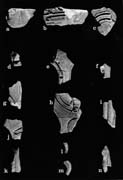Select a site alphabetically from the choices shown in the box below. Alternatively, browse sculptural examples using the Forward/Back buttons.
Chapters for this volume, along with copies of original in-text images, are available here.
Object type: Fragments, probably from a cross [1]
Measurements: Various. See 'Description' section.
Stone type: Fine-grained, oolitic, dolomitic, white (10YR 8/2) limestone, with ooliths diagenetically removed; see no 1.
Plate numbers in printed volume: 337-338
Corpus volume reference: Vol 3 p. 104-105
(There may be more views or larger images available for this item. Click on the thumbnail image to view.)
Apart from fragment b, all pieces are carved on only one face.
a: Rising from a flat surface is a small boss, 5.8 cm (2.3 in) in diameter, with a flat top.
b: A corner fragment. On one face (Ill. 338), an outer roll moulding flanks a thinner roll. Within these (top as shown) lie faint incised arcs on a flat surface. The adjacent face (Ill. 337) has a double roll moulding along one edge.
c: A series of narrow roll mouldings lie in a concentric arc. The section of the cutting is steep on one edge and inclined on the other.
d: A section of narrow, modelled strand. The groove is cut with one steep and one shallowly pitched side.
e: Two joining pieces, which form two diverging arcs, which are double-outlined, the left-hand one returning in a cusp; this side is flanked by a deep groove.
f: See fragment n, below.
g: Part of a parabolic motif, with parts of two diverging arcs which are double-outlined. The right-hand arc has a lightly incised moulding, while that on the left is deeply grooved and has an adjacent humped moulding.
h: Formed of several small joining pieces. Part of a small, flat boss rises from a flat surface; adjoining it is a pair of incised arcs forming a low roll moulding. On the left-hand side is part of another diverging parabolic curve, carved in low relief.
i: The only carving consists of two adjacent narrow roll mouldings.
j: On the lower right corner (as shown), two narrow, modelled roll mouldings, cut with inclined planes, rise towards a rim. Below is a flat area containing an incised arc, concentric with the roll mouldings. At the upper left corner is a short section of straight, lightly modelled moulding.
k: A straight, narrow moulding flanks four fragmentary incised bands at right angles to it.
l–m: Two fragments of slender moulding, curving in an arc.
n: Two adjacent half-inch roll mouldings terminate in a flat arrow-head. Fragment f joins with this piece.
Measurement of each fragment as follows
| Fragment | L or H | W. | D. | York Archaeological Trust No |
|---|---|---|---|---|
| a. | 9.5 cm (3.75 in) | 6.8 cm (2.7 in) | 3.5 cm (1.4 in) | 7257 |
| b. | 10.2 cm (4 in) | 5 cm (2 in) | 10.8 cm (4.25 in) | 7112 |
| c: | 8.5 cm (3.3 in) | 7.3 cm (2.9 in) | 7.6 cm (3 in) | 7187 |
| d: | 4.5 cm (1.75 in) | 3.5 cm (1.4 in) | 3 cm (1.2 in) | 7211 |
| e: | 17 cm (6.7 in) | 8 cm (3.1 in) | 2.8 cm (1.1 in) | 7270, 7272 |
| f: | 5.2 cm (2 in) | 3.6 cm (1.4 in) | 2.4 cm (1 in) | 7320 |
| g: | 9.5 cm (3.75 in) | 4 cm (1.6 in) | 2.2 cm (0.9 in) | 7258 |
| h: | 13.3 cm (5.2 in) | 9.5 cm (3.75 in) | 1.6 cm (0.6 in) | 7273, 7274–5, 7287 |
| i: | 9 cm (3.5 in) | 4 cm (1.6 in) | 2 cm (0.8 in) | 7181 |
| j: | 6.5 cm (2.6 in) | 6.2 cm (2.4 in) | 3.6 cm (1.4 in) | 7193 |
| k: | 8 cm (3.1 in) | 3.5 cm (1.4 in) | 1.5 cm (0.6 in) | 7283 |
| l: | 3.3 cm (1.3 in) | 1 cm (0.4 in) | 7319 | |
| m: | 4.6 cm (1.8 in) | 1.2 cm (0.5 in) | 7210 | |
| n: | 9.2 cm (3.6 in) | 2.8 cm (1.1 in) | 2.4 cm (1 in) | 7238 |
This collection of fragments appears to have come from a single monument of some quality. The cutting style in low relief, with finely modelled bands cut from a groove with a steep and shallow slope, is common to several of the fragments (e, g–h) may have been parts of a low relief cross with expanded arms, very like Minster 25 (Ill. 105). Fragments a and h contain parts of bosses, demonstrating the likelihood of the monument having been a cross. Some of the moulding fragments suggest spiral scrolls in a delicate style: compare Minster 1 (Ill. 1). The corner fragment, b, also suggests a shaft.
The fragments are all extremely thin and it appears that the relief carving was chiselled off to dress the stone for other purposes. Only the debris survived in the archaeological record.
1. The following is a general reference to the Coppergate stones: Hall 1980b, 8-9.
2. Fragments f and n have been reunited since Ill. 338 was taken.



